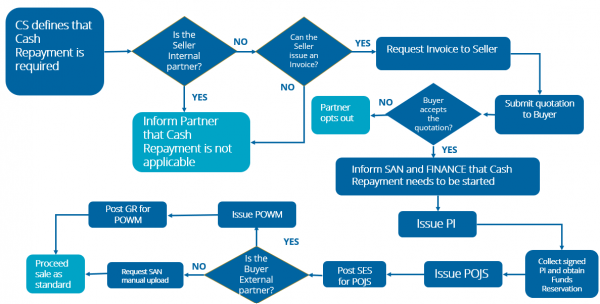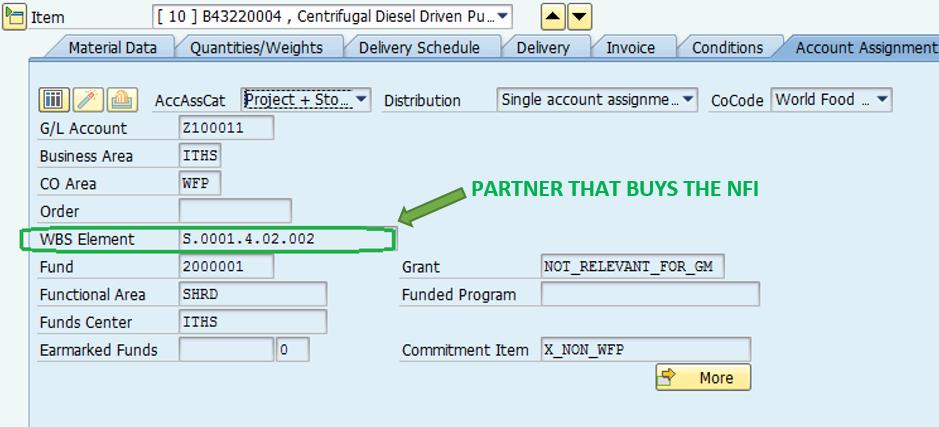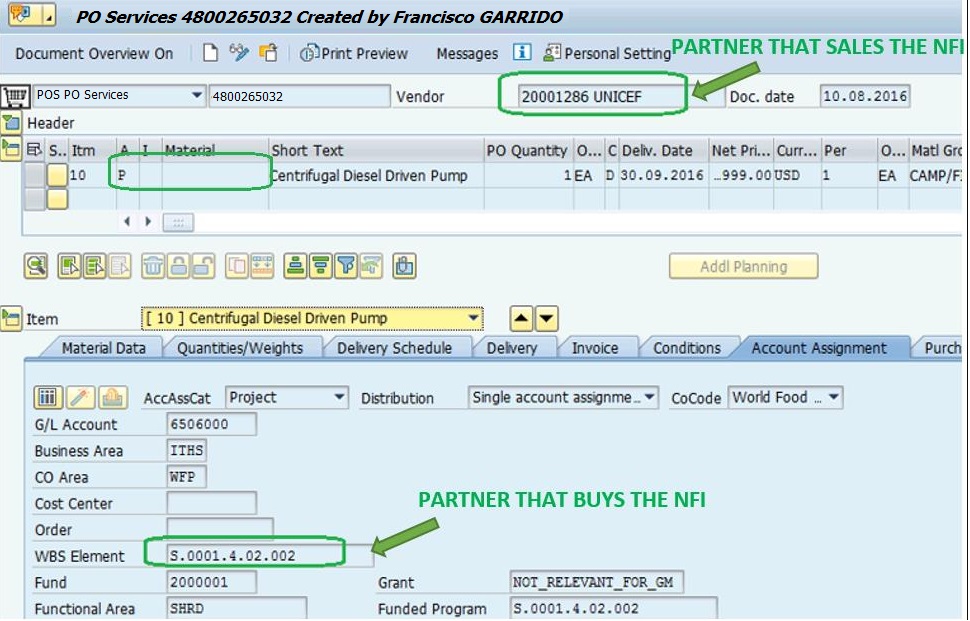3.3.2 Sales Order with Cash Repayment: Difference between revisions
No edit summary |
|||
| (80 intermediate revisions by the same user not shown) | |||
| Line 1: | Line 1: | ||
== Cash repayment: overview == | |||
UNHRD Sales process includes the sales of items between Partners. As per the Memo from UNHRD Network Coordinator ([http://unhrd.org/sites/default/files/memorandum_for_cash_repayment.pdf Memorandum for Cash Repayment.pdf]) this process can be applied to sale of items stored by UNHRD on behalf of External Partners and can't be applied on WFP stocks. | |||
This process is usually applied when an External Partner requires the cash repayment of the items requested by another Partner, either internal or external, rather than approving the loan of same items. In case loan is not accepted, '''as a last resort''', UNHRD can assist in purchasing stock from other partners. Cash Repayment should not be proposed and should be adopted ONLY as a last option | |||
Cash Repayment '''should not be proposed to external Partners''' and should be adopted only as a last option upon stock owner request. Customer Service has to ensure that the regular Loans and Borrowing process is utilized as much as possible, which is strategic for UNHRD. | |||
Cash Repayment is not a method to close an open loan and has nothing to do with a loan. In fact, the partner willing to buy NFIs is identified as a Buyer and the partner willing to sell NFIs is identified as a '''SELLER'''. | |||
Cash Repayment process should not be offered and can be applied only if the Seller is in the position to issue an Invoice or a Debit Note to receive the payment of the items sold to other UNHRD Partners. | |||
'''NOTE:''' Cash Repayment process is '''exclusively applicable if the External Partner acting as Seller is able to issue an Invoice or a Debit Note to be used for the settlement of the sale'''. Therefore, when UNHRD Customer Service assistant receives a request from an External Partner to apply the Cash Repayment process, he/she '''must ensure in advance''' that the Partner is clearly acquainted of the above requirement. | |||
[[File:Cash repayment.png|600px]] | |||
The process is separated in various phases: '''sale from seller's stock''', '''procurement to buyer's stock''' and '''payment to seller'''. | |||
The Partner that approves to sale its materials is identified as '''SELLER''' while the Partner that request for the materials is identified as '''BUYER'''. The Partner that acts as Seller is treated as '''Vendor''' and as such it is identified in the Cash Repayment process. | |||
Only External Partners can act as Vendor in the cash repayment process while items can be sold to either Internal or External Partners. UNHRD is not allowed to sell Inventory Stock recorded under WFP accounts. The Sales process managing this solution falls under standard UNHRD Sales procedure (i.e. 7% of MRC is applicable) while sales value is established by the External Partners acting as Vendors and mutually agreed by the Partners, as specified in Chapter 5 of UNHRD SOP. The value of the goods sold must be in line with the Invoice provided by the Partner acting as Seller. | |||
The steps required to complete the Cash Repayment process are listed below: | |||
'''1. Procurement of materials to Buyer’s stock:''' this is completed at hub level (when buyer is an External Partner) or by Support Office (when buyer us Internal Partner) applying value of goods sold (i.e. Seller's Invoice value) | |||
'''2. Sale of materials from Seller’s stock:''' this is performed at hub level by applying value of goods sold (i.e. Seller's Invoice value) | |||
'''3. Payment to Seller:''' this is performed by Finance units and reflects the value established by Seller (i.e. Invoice value) and agreed by Buyer | |||
'''4. Removal of stock from Seller's account:''' this is performed by Support Office through a manual decrease from the Seller's stock (i.e. MAP value) | |||
== Procurement of materials to Buyer’s stock == | |||
In case the '''Buyer is an External Partner''', this part of the process is managed at Hub level by creating a POWM to receive the items under the Partner's stock. The Vendor code associated to the Partners that sales the NFI (the Seller) has to be picked from the list of WINGS Vendor Codes. In case the Partner does not have a Vendor Code associated in WINGS, the standard request to WFP Vendor Master for Warehouse Management purposes has to be submitted by UNHRD Focal Points for WFP Vendor Master issues. '''The value to be adopted has to match with value of Invoice provided by the seller'''. The remaining POWM specifications have to be entered as for any POWM created for the receipt in Warehouse Management for External Partners NFIs: | |||
[[File:POWN s.jpg]] | [[File:POWN s.jpg]] | ||
| Line 16: | Line 38: | ||
This part of the process is completed by posting the GR versus the POWM. | This part of the process is completed by posting the GR versus the POWM. | ||
In case the '''Buyer is an Internal Partner''', this part of the process is managed by WM experts at Support Office (SAN) by performing a manual upload (with Movement Type 561) adopting same material code and applying the value reported on the Invoice provided by the seller. | |||
== ''' | == Sale of materials from Seller’s stock == | ||
In order to perform the cash repayment against Seller's account, Customer Service representatives issue a '''PO Service''' (i.e. POS type), applying Purchase Organization UNJS: | |||
[[File:POJS1.png|400px]] | |||
By doing this WINGS creates the so called POJS, which is a type of POs issued when the supplier is an UN Joint or Statutory - no-profit- entity. | |||
The vendor code to apply to the POJS has to be the one associated to the Seller and if it does not exist or if it is not extended to POJSs standard process for creation/extension of vendor code has to be followed. | |||
The POJS is completed by entering the lines that reflect the stock that the Seller agreed to sell to the Buyer: specifications for the line items are listed below: | |||
* "P" as account assignment | |||
* Item category to remain empty, so that a GR will be posted to start payment for Seller | |||
* Material codes to be entered to reflect the items that are meant to be soled to Buyer | |||
* Net value to reflect the value of sell mutually agreed by the Partners (i.e., in line with invoice provided by the Seller) | |||
* Remaining specifications to reflect standard data entry | |||
[[File:POJS2.png|400px]] | |||
As good practice, attach a copy of the invoice issued by the Seller for internal references. | |||
'''NOTE''' POJSs have to be released by Network Coordinator (NC) as last approving level. This is because POJSs have their own Purchase Organization code, i.e. UNJS, and thereof the release strategy falls under Corporate structure that foresees CD as second level of approval: in this case, being NC's approval equivalent to CD`s, second approval on POJS posted by UNHRD falls under Network Coordinator authority. | |||
== Payment to Seller == | |||
This part of the process is started at Hub Level by following below steps: | |||
* '''1:''' Once Customer Service Representative obtains the Invoice from the Partner acting as Vendor, a Purchase Requisition for Services has to be created. Account assignment to be adopted in the PRS has to be P for "Project' while the Item Category has to be left empty (this reflects the procurement of NFIs from the Partner acting as Vendor). PRS has to be releases by following the standard Corporate process. | |||
* '''2:''' Customer Service Representative creates the PO for Services from the PRS by selecting the Partner's associated Vendor number, adopting '''UNJS''' for ‘UN Joint & Statutory’ as Purchase Organisation, and the owned Purchasing group (e.g. AE9, IT9, GH9, etc.). | |||
[[File:PO2ve.jpg]] | [[File:PO2ve.jpg]] | ||
If it does not exist in WINGS Vendor database, Customer Service Representative has to request the creation of a new Vendor by following the standard Corporate process. The rest of the information is derived from the PRS created in previous step. POS has to be releases by following the standard process. | |||
* '''3:''' Logistics Staff post the GR versus the POJS | |||
* '''4:''' The process is completed by UNHRD Finance by performing the payment versus the POS and GR created | |||
== Removal of stock from Seller's account == | |||
To complete the Cash Repayment process, once the GR is posted against the POJS to pay the seller and once the items have been made available under Buyer's account (either through the POWM/GR issued at hub level or through manual upload performed by Support office), the stock sold to the Buyer is removed from Seller's account by a manual decreased posted by Support Office applying MAP value. | |||
Thereof, the WM Experts at Support Office ('''SAN''') upon receipt of confirmation for sale (i.e., GRs posted) performs the stock decrease from Sellers's balances, by applying a specific Movement Type - i.e. 567 - dedicated to Cash Repayment process. The value of decrease from Seller stock reflects the actual MAP value: | |||
[[File:Cashrepay111.png]] | |||
Revision as of 10:55, 29 July 2024
Cash repayment: overview
UNHRD Sales process includes the sales of items between Partners. As per the Memo from UNHRD Network Coordinator (Memorandum for Cash Repayment.pdf) this process can be applied to sale of items stored by UNHRD on behalf of External Partners and can't be applied on WFP stocks.
This process is usually applied when an External Partner requires the cash repayment of the items requested by another Partner, either internal or external, rather than approving the loan of same items. In case loan is not accepted, as a last resort, UNHRD can assist in purchasing stock from other partners. Cash Repayment should not be proposed and should be adopted ONLY as a last option Cash Repayment should not be proposed to external Partners and should be adopted only as a last option upon stock owner request. Customer Service has to ensure that the regular Loans and Borrowing process is utilized as much as possible, which is strategic for UNHRD. Cash Repayment is not a method to close an open loan and has nothing to do with a loan. In fact, the partner willing to buy NFIs is identified as a Buyer and the partner willing to sell NFIs is identified as a SELLER. Cash Repayment process should not be offered and can be applied only if the Seller is in the position to issue an Invoice or a Debit Note to receive the payment of the items sold to other UNHRD Partners.
NOTE: Cash Repayment process is exclusively applicable if the External Partner acting as Seller is able to issue an Invoice or a Debit Note to be used for the settlement of the sale. Therefore, when UNHRD Customer Service assistant receives a request from an External Partner to apply the Cash Repayment process, he/she must ensure in advance that the Partner is clearly acquainted of the above requirement.
The process is separated in various phases: sale from seller's stock, procurement to buyer's stock and payment to seller. The Partner that approves to sale its materials is identified as SELLER while the Partner that request for the materials is identified as BUYER. The Partner that acts as Seller is treated as Vendor and as such it is identified in the Cash Repayment process. Only External Partners can act as Vendor in the cash repayment process while items can be sold to either Internal or External Partners. UNHRD is not allowed to sell Inventory Stock recorded under WFP accounts. The Sales process managing this solution falls under standard UNHRD Sales procedure (i.e. 7% of MRC is applicable) while sales value is established by the External Partners acting as Vendors and mutually agreed by the Partners, as specified in Chapter 5 of UNHRD SOP. The value of the goods sold must be in line with the Invoice provided by the Partner acting as Seller.
The steps required to complete the Cash Repayment process are listed below:
1. Procurement of materials to Buyer’s stock: this is completed at hub level (when buyer is an External Partner) or by Support Office (when buyer us Internal Partner) applying value of goods sold (i.e. Seller's Invoice value)
2. Sale of materials from Seller’s stock: this is performed at hub level by applying value of goods sold (i.e. Seller's Invoice value)
3. Payment to Seller: this is performed by Finance units and reflects the value established by Seller (i.e. Invoice value) and agreed by Buyer
4. Removal of stock from Seller's account: this is performed by Support Office through a manual decrease from the Seller's stock (i.e. MAP value)
Procurement of materials to Buyer’s stock
In case the Buyer is an External Partner, this part of the process is managed at Hub level by creating a POWM to receive the items under the Partner's stock. The Vendor code associated to the Partners that sales the NFI (the Seller) has to be picked from the list of WINGS Vendor Codes. In case the Partner does not have a Vendor Code associated in WINGS, the standard request to WFP Vendor Master for Warehouse Management purposes has to be submitted by UNHRD Focal Points for WFP Vendor Master issues. The value to be adopted has to match with value of Invoice provided by the seller. The remaining POWM specifications have to be entered as for any POWM created for the receipt in Warehouse Management for External Partners NFIs:
This part of the process is completed by posting the GR versus the POWM.
In case the Buyer is an Internal Partner, this part of the process is managed by WM experts at Support Office (SAN) by performing a manual upload (with Movement Type 561) adopting same material code and applying the value reported on the Invoice provided by the seller.
Sale of materials from Seller’s stock
In order to perform the cash repayment against Seller's account, Customer Service representatives issue a PO Service (i.e. POS type), applying Purchase Organization UNJS:
By doing this WINGS creates the so called POJS, which is a type of POs issued when the supplier is an UN Joint or Statutory - no-profit- entity. The vendor code to apply to the POJS has to be the one associated to the Seller and if it does not exist or if it is not extended to POJSs standard process for creation/extension of vendor code has to be followed. The POJS is completed by entering the lines that reflect the stock that the Seller agreed to sell to the Buyer: specifications for the line items are listed below:
- "P" as account assignment
- Item category to remain empty, so that a GR will be posted to start payment for Seller
- Material codes to be entered to reflect the items that are meant to be soled to Buyer
- Net value to reflect the value of sell mutually agreed by the Partners (i.e., in line with invoice provided by the Seller)
- Remaining specifications to reflect standard data entry
As good practice, attach a copy of the invoice issued by the Seller for internal references.
NOTE POJSs have to be released by Network Coordinator (NC) as last approving level. This is because POJSs have their own Purchase Organization code, i.e. UNJS, and thereof the release strategy falls under Corporate structure that foresees CD as second level of approval: in this case, being NC's approval equivalent to CD`s, second approval on POJS posted by UNHRD falls under Network Coordinator authority.
Payment to Seller
This part of the process is started at Hub Level by following below steps:
- 1: Once Customer Service Representative obtains the Invoice from the Partner acting as Vendor, a Purchase Requisition for Services has to be created. Account assignment to be adopted in the PRS has to be P for "Project' while the Item Category has to be left empty (this reflects the procurement of NFIs from the Partner acting as Vendor). PRS has to be releases by following the standard Corporate process.
- 2: Customer Service Representative creates the PO for Services from the PRS by selecting the Partner's associated Vendor number, adopting UNJS for ‘UN Joint & Statutory’ as Purchase Organisation, and the owned Purchasing group (e.g. AE9, IT9, GH9, etc.).
If it does not exist in WINGS Vendor database, Customer Service Representative has to request the creation of a new Vendor by following the standard Corporate process. The rest of the information is derived from the PRS created in previous step. POS has to be releases by following the standard process.
- 3: Logistics Staff post the GR versus the POJS
- 4: The process is completed by UNHRD Finance by performing the payment versus the POS and GR created
Removal of stock from Seller's account
To complete the Cash Repayment process, once the GR is posted against the POJS to pay the seller and once the items have been made available under Buyer's account (either through the POWM/GR issued at hub level or through manual upload performed by Support office), the stock sold to the Buyer is removed from Seller's account by a manual decreased posted by Support Office applying MAP value. Thereof, the WM Experts at Support Office (SAN) upon receipt of confirmation for sale (i.e., GRs posted) performs the stock decrease from Sellers's balances, by applying a specific Movement Type - i.e. 567 - dedicated to Cash Repayment process. The value of decrease from Seller stock reflects the actual MAP value:





